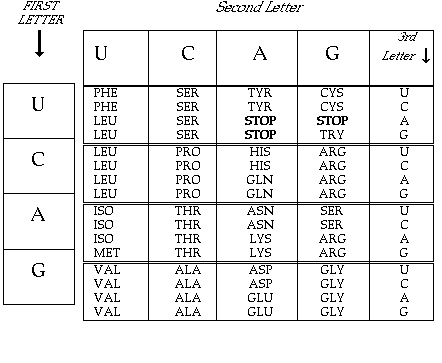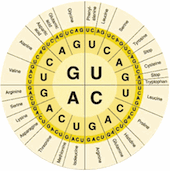That's a great question, and it points to our priorities in putting together the illustration progrfam for our textbook. The traditional code table is rectangular, which is confusing for many students. For example, let's suppose that we had to translate the codon AAA using the rectangular code table shown at the left.
First, we'd use the left hand column to find the letter A, and see that the codon is somewhere in the third large row.
Second, remembering where our first letter was, we find the second letter at the top of the table. We then move down the column headed by the letter A, and find the intersection between this column and the third row. Unfortunately, there are two possible amino acids at the intersection, ASN and LYS.
Third, to determine the exact amino acid, we now have to go to the right hand column, and find the third letter of the codon. Then, once we've found it, we can go back across and see that it lines up with LYS (lysine). Phew!
Confusing enough? Fortunately, there is another way to present the genetic code, and this is our Circular Genetic Code table. A simple version of this is shown at the left. Look up the same codon (AAA), and the advantages of the circular code table become clear.
We simply place a pointer at the large A in the center of the wheel, which repsesents the first letter of the code. We then draw that pointer outward, going directly to the second letter (A) and once we're there, we keep moving, and go to the third letter (also A), which sits right next to the label LYS (lysine).
Not once did we have to move to the other side of the table, line up a row and a column, or do anything other than trace a direct path from one letter of the codon to the next
Click Here for a graphic explanation of how to use the circular table from page 367 of the Macaw book.
![]()


